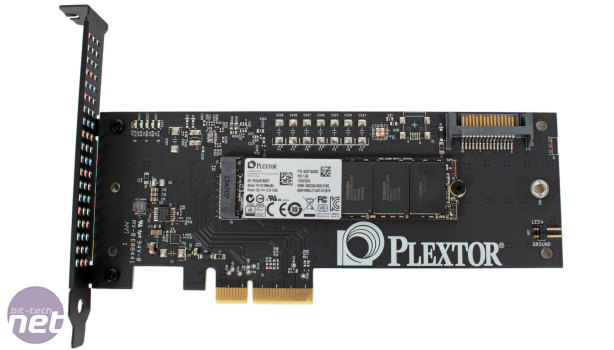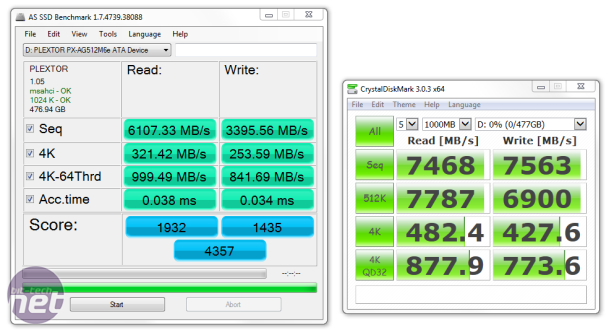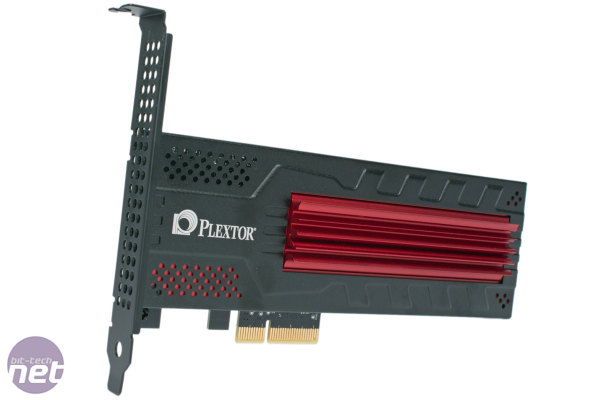
Performance Analysis
Immediately we see the PCI-E interface at work; the M6e Black Edition has much faster sequential read and write speeds than any SATA-based SSD. For example, it manages reads of 723MB/sec in CrystalDiskMark when others are limited to 550MB/sec, and almost 650MB/sec writes in AS SSD compared to around 500MB/sec for the fastest 2.5in drives.However, random performance does not show anything off. The single queue depth tests reveal middling read performance and write performance that's actually bottom of the charts. Remember, these are only synthetic tests, but it does highlight the limitations of the hardware and AHCI – performance is very close to Plextor's similar M6 Pro here. At high queue depths, performance is stronger, and interestingly it's much better in the 64QD AS SSD tests than the 32QD CrystalDiskMark ones, although it's no better than the best SATA SSDs either.
This performance snapshot translates well into the real world tests, giving the M6e Black Edition the best result so for the Starting Applications workload. It has a strong result in the Gaming one too, although a number of drives are faster yet – most of Samsung's current line-up, for example. Windows boot times are also very respectable, although they're nothing outstanding either.
Moving to the Iometer workloads, the M6e Black has a massive advantage over the SATA drives in nearly every mixed workload test, as well as the sustained read test (Web Server). These tests are all run at a queue depth of 64, and we saw it did well here in AS SSD too. That said, consistency over time is not that great – after the 12 hour battery, average IOPS and average response times end up being little better than when using an entry-level SSD such as the Crucial MX100.
PlexTurbo
As you can see above, activating PlexTurbo brings about massive performance increases in AS SSD and CrystalDiskMark since data cached in RAM is many times faster to write and access. Peak speeds are above 7GB/sec, and random performance is much improved, although even within these two benchmarks there is a lot of variation. We also re-ran PCMark 7 for a closer idea of real-world impact, and in this instance there was little effect, at least in the two workloads we're focussed on – in one, it went up by a few MB/sec, and in the other it went down by a few. In your actual experience this would not be noticeable – the overall secondary storage score in the test increased by less than 1 percent.
Conclusion
PCI-E storage is still relatively new and there are few options on the market, so elevated costs are to be expected. Compared to the standard M6e standalone M.2 drive and expansion card, the M6e Black Edition is not a terrible deal. You get a much needed aesthetic upgrade plus the added bonus of cooler running hardware for about £30.However, compared to other options, it's a hard sell. For example, the Kingston HyperX Predator is available for around the same price, and while it has slightly less capacity (480GB) and no cooler, it does come in black and it's capable of speeds of 1GB/sec and more thanks to its expanded PCI-E 2.0 x4 interface and controller. Meanwhile, the newly released Intel SSD 750 is even faster thanks to using PCI-E 3.0 x4 and the NVMe specification. The 400GB one costs £345, which is around 10p more per GB, but arguably if you're looking for PCI-E storage right now you're doing so for speed, not value for money – 512GB 2.5in drives can easily be found for less than half the cost of this M6e Black Edition, and in most home user and even “extreme gaming” workloads you won't notice a difference in speed.
Finally, while PlexTurbo, like RAPID Mode, looks hugely compelling in some benchmarks, others reveal that it doesn't bring many benefits. To be sure, it will speed certain things up, especially as it learns your data usage patterns. It is therefore a useful tool to have, but it's not a reliable indicator of faster performance and it's also available with the Plextor M6 Pro which is far cheaper. Admittedly, though, the M6e drives are the only PCI-E ones that currently support a RAM caching technology.
PCI-E storage will certainly take off, and in a year's time there will be many more M.2 drives, add-in cards like this one and even 2.5in drives using SATA Express or the new SFF-8639 port. Plextor itself has already announced the M7e, for example, which will use a wider PCI-E 2.0 x4 interface like the HyperX Predator. For now, however, the price of such drives keeps them squarely in high-end enthusiast territory, where people will pay extra to have the best. Even for such people though, unless the M6e Black Edition's colour scheme makes this drive a perfect match, there's little reason not to look at the few remaining options.

MSI MPG Velox 100R Chassis Review
October 14 2021 | 15:04











Want to comment? Please log in.